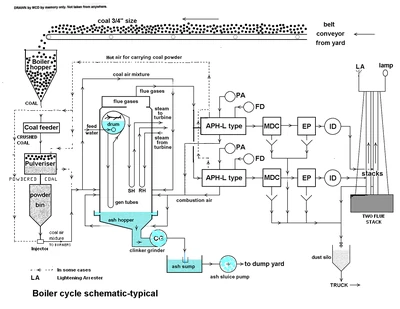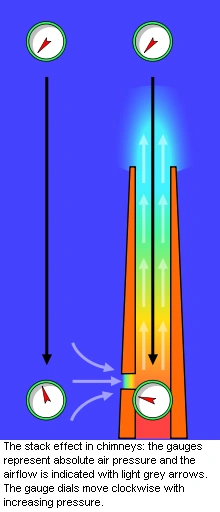A Chimney is a self standing structure for venting hot gases from a boiler to the outside atmosphere [1] and to disperse them at a considerable height.
Other definition[]
The word 'chimney' also refers to a system for venting hot gases and smoke from a stove, furnace or fireplace to the outside atmosphere. They are typically almost vertical to ensure the hot gases flow smoothly, drawing air into the combustion through convection or forced by fans.
Construction[]
In a thermal power station the chimney forms a very important subject of design and utility. These chimneys are some times known as stacks.
They are always vertical to ensure the hot gases flow smoothly. The gas flow on each boiler is assisted by forced draft fans forcing the atmospheric air into combustion chamber and also assisted by Induced draft fans sucking out the combustion gases from the combustion chamber.
Generally in large units (110 MW or more) of power stations two boilers are connected to one chimney. The chimney in this case will have two flues inside, each working independently for each boiler. Necessary dampers are also provided for isolation of each boiler from safety point, considering operation and workmen.
Today the use of single-pour concrete for construction has almost entirely replaced brick in this role. They can be as tall as about 300 m. The height is to ensure that the pollutants are dispersed over a wider area to meet legislative requirements.
The inside of chimney at bottom of each flue is designed to remove fly ash collected.
The inside surface in contact with flue gases is also coated with acid resisting paint to avoid acidic attack by the flue gases on the concrete surface.
Regulations[]
The height has to comply to the local regulations in force with additional requirements if near an air port area.
Air craft warning lights are also provided at the top to identify this tall structure by air crafts flying over.
The top of the chimney (susceptible for lightening strokes due to its height)is also provided with lightening arrestors to conduct them directly to ground.
Chimney draught or draft[]
When coal, oil, natural gas, wood or any other fuel is combusted in a stove, oven, fireplace, hot water boiler or industrial furnace, the hot combustion product gases that are formed are called flue gases. Those flue gases are generally exhausted to the ambient outside air through a chimneys or so-called stacks (sometimes referred to as smokestacks).
The combustion flue gases inside the chimneys or stacks are much hotter than the ambient outside air and therefore less dense than the ambient air. That causes the bottom of the vertical column of hot flue gas to have a lower pressure than the pressure at the bottom of a corresponding column of outside air. That higher pressure outside the chimney is the driving force that moves the required combustion air into the combustion zone and also moves the flue gas up and out of the chimney. That movement or flow of combustion air and flue gas is called "natural draught/draft", "natural ventilation", "chimney effect", or "stack effect". The taller the stack, the more draught or draft is created.
It should be noted that not all ovens, boilers or industrial furnaces rely upon natural draught or draft. Many ovens, boilers and furnaces use fans or blowers to accomplish the same objectives, namely: the flow of combustion air into the combustion chamber and the flow of the hot flue gas out of the chimney or stack.
Designing chimneys and stacks to provide the correct amount of natural draught or draft involves a great many factors such as:
- The height and diameter of the stack.
- The desired amount of excess combustion air needed to assure complete combustion.
- The temperature of the flue gases leaving the combustion chamber.
- The composition of the combustion flue gas, which determines the flue gas density.
- The frictional resistance to the flow of the flue gases through the chimney or stack, which will vary with the materials used to construct the chimney or stack.
- The heat loss from the flue gases as they flow through the chimney or stack.
- The local atmospheric pressure of the ambient air, which is determined by the local elevation above sea level.
The calculation of many of the above design factors requires trial-and-error reiterative methods.
Governmental agencies in most countries have specific codes which govern how such design calculations must be performed. Many non-governmental organizations also have codes governing the design of chimneys and stacks (notably, the ASME codes).
As a "first guess" approximation, the following equation can be used to estimate the natural draught/draft flow rate by assuming that the molecular mass (i.e., molecular weight) of the flue gas and the external air are equal and that the frictional pressure and heat losses are negligible: [2]
| where: | |
| Q | = chimney draught/draft flow rate, m³/s |
|---|---|
| A
|
= cross-sectional area of chimney, m² (assuming it has a constant cross-section) |
| C | = discharge coefficient (usually taken to be from 0.65 to 0.70) |
| g | = gravitational acceleration, 9.807 m/s² |
| H | = height of chimney, m |
| Ti | = average temperature inside the chimney, K |
| Te | = external air temperature, K |
Remarkable Chimneys (not updated)[]
| Chimney | Year | Country | Town | Pinnacle height | Remarks | |
|---|---|---|---|---|---|---|
| GRES-2 Power Station | 1987 | Kazachstan | Ekibastusz | 419.7 m | 1362 ft | Tallest chimney in the world |
| Inco Superstack | 1971 | Canada | Copper Cliff | 385 m | 1263 ft | Tallest freestanding chimney |
| Kennecott Smokestack | ? | United States | Garfield, Utah | 380 m | 1246 ft | |
| Chimney of Homer City Generating Station | 1977 | USA | Minersville, Pennsylvania | 371 m | 1219 ft | |
| Chimney of Mitchell Power Plant | 1971 | USA | Moundsville, West Virginia | 367,6 m | 1207 ft | |
| Trbovlje Chimney | 1976 | Slovenia | Trbovlje | 364 m | 1207 ft | |
| Endesa Termic | 1974 | Spain | La Coruña | 356 m | 1207 ft | |
| Chimney of Syrdarya Power Plant | 1975 | Uzbekhistan | Syrdarya | 350 m | 1149 ft | |
| Chimney of Teruel Power Plant | ? | Spain | Tereul | 343 m | 1149 ft | |
| Chimney of Plomin Power Station | ? | Croatia | Plomin | 340 m | 1149 ft | |
| Chimney of Power Station Westerholt | 1997 | Germany | Gelsenkirchen | 337.5 m | 1107 ft | |
| Chimney of Power Station Jaworno | ? | Poland | Jaworno | 300 m | 984 ft | |
| Chimneys of Power Station Belchatow | 1979 | Poland | Belchatow | 300 m | 984 ft | |
| Chimney of Power Station Kozienice | ? | Poland | Kozienice | 300 m | 984 ft | |
| Chimney of Power Station Warszawa-Kawcyn | ? | Poland | Warszawa-Kawcyn | 300 m | 984 ft | |
| Chimneys of Navajo Generating Station | ? | United States | Page, Arizona | 236 m | ||
| Anaconda Smelter Stack | 1919 | USA | Anaconda, Montana | 178.3 m | built of bricks | |
Other uses[]
Chimneys may be found in buildings, power plants, steam locomotives and ships (for the latter, the US term is smokestack).
A rare use of chimney serving as pylons is also indicated under external links.
The adjacent sketch shows the method of connection to the boilers in thermal power stations.
External links[]
| This page uses Creative Commons Licensed content from Wikipedia (view authors). | 
|


